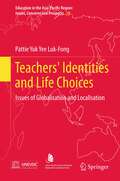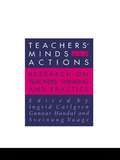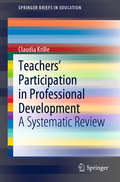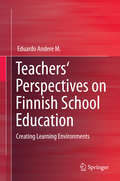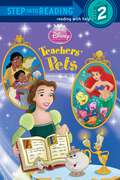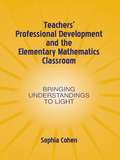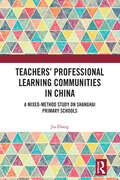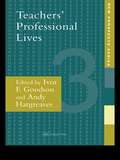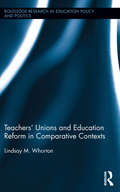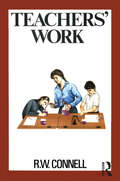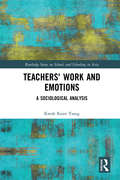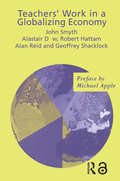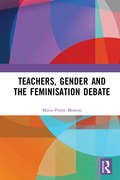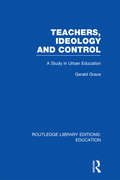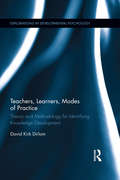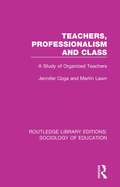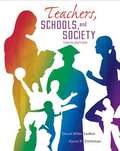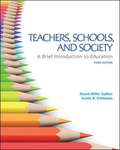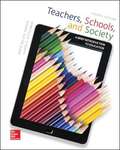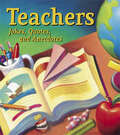- Table View
- List View
Teachers' Identities and Life Choices
by Pattie Luk-FongThis book discusses issues related to teachers' identities and life choices when globalisation and localisation are enmeshed. It examines how competing cultural traditions and contexts acted as resources or/and constraints in framing teachers' identities and their negotiations in the family and the work domains according to their gender positioning, their roles in the family such as husband, wife, father, mother, brother, sister, son and daughter and roles in the school such as principal, senior teacher or regular teacher. Contrary to an essentialist approach to identity and culture, teachers' stories show that their identities and life choices were hardly free choices; but were often part and parcel of the culture and contexts in which they were embedded. Teachers' identities are found to be fluid, complex, hybrid and multifaceted. Using Hong Kong as a case study, this book provides not only traces of the continuity and changes of Confucian self and cardinal relationships but also a glimpse of how educational reform as neo-capitalist discourses in the workplace interacts with Confucian cultural traditions creating new hybrid practices (problems or possibilities or both) in the school and in the daily lives of teachers.
Teachers' Lives And Careers (Open University Set Text Ser.)
by Stephen J Ball & Ivor F. GoodsonFirst published in 1985. Routledge is an imprint of Taylor & Francis, an informa company.
Teachers' Minds And Actions: Research On Teachers' Thinking And Practice
by Gunnar Handal Sveinung VaageBased on the 10th International Study Association on Teacher Thinking and Practice Conference in Gothenburg, this text contains a collection of original research conducted by scholars from Europe, North America, Israel and Hong Kong, and provides an overview of the current status of international research on teacher thinking.; The contributors write from different perspectives - some analytical, some philosophical and some contextual - on the way teachers think and act. The intention of the book is not to characterise critically the established traditions or any of its researchers, but to study teacher-thinking research in context, analysing research objectives and enquiring into what lies behind the traditions. The result is a picture of an unpredictable but exciting and interesting future in developments in teacher-thinking research.
Teachers' Participation in Professional Development: A Systematic Review (SpringerBriefs in Education)
by Claudia KrilleThis book presents a systematic literature review focusing on studies examining teachers’ participation in professional development (PD) within Germany, Austria, and Switzerland since 1990. It has identified 81 relevant studies and summarizes the results while answering the following research questions: What are teachers’ self-reported reasons participate in formal PD? What barriers do teachers report that prevent them to participate in formal PD? What individual and context characteristics are associated with teachers’ PD behavior? Teachers’ PD is considered to be an important part of the teaching profession. It is seen as a tool for constant further development for teachers to adapt to changing standards in schools and classrooms, requirements for students, and personal challenges associated with the daily work in school. However, it is repeatedly claimed that there is no sufficient research with regard to teachers’ participation in formal PD, as well as of aspects that may influence their PD behavior. In spite of a large number of studies that contribute to this question within Germany, Austria, and Switzerland, only a few of them are cited regularly. Since much of this research is published in German, the results are not accessible for international researchers and comparisons between different countries. This comprehensive review makes these result accessible.
Teachers' Perspectives on Finnish School Education
by Eduardo Andere M.This superbly researched study offers a chalk-face perspective on the secret of Finland's educational success. Providing an intimate and revealing portrait of the Nordic nation's schools and its teacher training system, it sets out to explain why Finland's students consistently rank top, with low variance and moderate inputs, among OECD countries across the range of criteria, from reading to mathematics. Alongside the detailed analysis culled from many hours of interviews with teachers and principals and dozens of visits to school throughout the country, the author maps the educational landscape of Finland: the sector's history, culture and development, its guiding principles, methodologies, and learning environments. The result is a cogent assessment of how and why Finland is universally regarded as a high-grade educational exemplar. The volume provides the hundreds of researchers, teaching professionals, and policy makers who visit Finland in search of inspiration with essential background material on the country's magic educational ingredients, which include a highly motivated cohort of well-trained teachers, a recognition of the vital importance of early years education and nurture, functional and inviting learning environments, and a rejection of pedagogical dogma in favour of developing methodologies that produce results at the same time as fostering students' confidence and collegiality. At the same age, Finland's schoolchildren have roughly one less year of formal schooling than most of their international counterparts, do not consider themselves to be overworked, and rank alongside hot-housed Singaporean or South Korean youngsters in international assessments of achievement. They are the educational equivalent of world-beating sports stars who make success appear effortless. This volume lifts the lid on the hard work and careful planning that underpin their achievements.
Teachers' Pets (Step into Reading)
by Mary Man-KongJoin Belle, Tiana, and the rest of the Disney princesses as they teach their friends how to read, cook, swim, and more! Based on the beloved Disney films Beauty and the Beast, The Princess and the Frog, The Little Mermaid, and more, this Step 2 reader will have girls ages 4 to 6 eager to be the teacher&’s pet.
Teachers' Professional Development and the Elementary Mathematics Classroom: Bringing Understandings To Light (Studies in Mathematical Thinking and Learning Series)
by Sophia CohenThis book illustrates the experiences of elementary school teachers across one year's time as they participated in a teacher development seminar focused on mathematics, and as a result changed their beliefs, their knowledge, and their practices. It explores these experiences as a means of understanding the learning that takes a teacher from a more traditional teaching practice to one that is focused on the ideas and understandings that students and teachers have of the subject matter. The work emerges from and reports on a unique data set from a two-year study of teacher learning that was funded by the Spencer and MacArthur foundations. The teachers, whose work is at the center of this study, were participants in the Developing Mathematical Ideas seminar (DMI), a mathematics teacher development seminar for elementary school teachers. This seminar is one example of intensive, domain-specific professional development. In this seminar teachers study elementary mathematics content to deepen their own understanding of it, they study the development among children of the ideas central to elementary mathematics, and they experience a teaching and learning environment consistent with the pedagogy envisioned by the National Council for Teachers of Mathematics' Principles and Standards for School Mathematics. The seminar is a nationally available teacher development curriculum, thus interested educators can gain access to the resources necessary to offer similar seminars in their own communities. Teachers' Professional Development and the Elementary Mathematics Classroom: Bringing Understandings to Light will be widely interesting to a broad audience, including mathematics teacher educators, teacher education researchers, policymakers, and classroom teachers. It will serve well as a text in a range of graduate courses dealing with teacher cognition/knowledge for teaching, mathematics methods, psychology of learning, and pedagogical theory.
Teachers' Professional Learning Communities in China: A Mixed-Method Study on Shanghai Primary Schools
by Jia ZhangThe book investigates how Chinese professional learning communities (PLCs) shape the professional practice of teachers and their psychological well-being. Adopting a mixed research approach, the author explores the influence of PLCs on teachers’ self-efficacy, commitment and job satisfaction in a number of schools in Shanghai, China. The study contributes to our understanding of PLC outcomes from the Chinese perspective, enriches our knowledge of how PLCs promote teachers’ psychological well-being, and also sheds light on how the practices of PLCs can be influenced by various institutional and socio-cultural forces. The book will be of interest to academics and students studying professional learning communities, teacher professional learning and professional development, school effectiveness and school improvement, and Chinese schooling.
Teachers' Professional Lives
by Ivor F. GoodsonFirst published in 2004. Routledge is an imprint of Taylor & Francis, an informa company.
Teachers' Unions and Education Reform in Comparative Contexts (Routledge Research in Education Policy and Politics)
by Lindsay WhortonTeachers’ unions have long been controversial and divisive organizations, but criticism and distrust of them may be at an all-time high. This volume considers the prevailing assumption that unions successfully block change in education because they are primarily motivated to protect members’ interests. It challenges the conceptualization of teacher union motivation and provides a more nuanced account of unions’ interests, power and impact. Through a series of international cases from the United States, Finland and the Canton of Zürich, this volume examines the hot-button issue of performance-related pay reform and compensation. It argues that a better understanding of the union-management relationship may be the key to securing more meaningful change and reform. It will be of use to scholars, policy-makers, union leaders, teachers and citizens who are interested in the possibilities for the union-management relationship, rather than the limitations.
Teachers' Work
by RW ConnellTeachers' Work is a highly readable, penetrating and often amusing account of the reality of teachers working lives, as relevant to the profession and its future as it was when first published in 1985. Based on the classic Australian study of the schools and homes of the wealthy and powerful and of ordinary wage-earners described in Making the Difference, Teachers' Work draws on extended interviews with teachers in elite private schools and mainstream government high schools and with the students and parents who attend and patronise them. As well as providing an absorbing account of the life and work of teachers through vivid portraits of people, classrooms and staffrooms, Teachers' Work illuminates the interaction between personal relationships in the classroom and the social structures of gender and class. In generating new ways of thinking about the character and origins of inequality in education, this book gives teachers themselves cause for reflection, offers student-teachers a picture of the real world of teaching, and provides parents with an insight into daily life behind the classroom door. At a time when the power of 'effective teaching' is being widely recognised and national debate focuses on the condition and prospcts of the teaching profession, Teachers' Work is as insightful and rewarding as ever.
Teachers' Work During the Pandemic (Critical Perspectives on Teaching and Teachers’ Work)
by Nina BasciaThis book examines teachers’ work in the first two years of the COVID-19 pandemic, where educators grappled with a worldwide virus that profoundly affected teaching and learning. This difficult situation allowed educators and researchers to reflect critically on the enduring labor experiences that persist through this uncertain period, some of them rooted in conditions prevalent long before the pandemic hit. Written from a perspective that cuts across labor studies and education, the book explains how cultural and legally inscribed expectations of teachers have been remarkably impermeable over time. In particular, the volume focuses on the educational transformations that have taken place worldwide since the pandemic occurred, including reduced educational resources, labor strife, and contradictory governmental directives. As the book articulates, these changes affect some of the most persistent educational topics, including student achievement, student health, and teacher satisfaction.
Teachers' Work and Emotions: A Sociological Analysis (Routledge Series on Schools and Schooling in Asia)
by Kwok Kuen TsangBeing a teacher is often thought of as an emotionally fulfilling job, with many positive experiences in watching students grow and mature. However, as Tsang’s research shows, there are plenty of negative emotional experiences in this line of work as well. Given the recent attention towards mental health and well-being, this book addresses these negative experiences and provides recommendations for dealing with them. Focusing on teachers in Hong Kong, Tsang investigates the social mechanisms that arouse such negative emotional experiences, otherwise known as caam2. He asserts that these feelings are socially constructed, and it is only by understanding the causes and feelings can we begin to improve teachers’ emotional well-being and teaching quality. Using a theoretical framework based on a critical review and synthesis of five existing perspectives, including labor process perspective, school administration perspective, emotional labor perspective, social interaction perspective, and teacher identity perspective, Tsang does precisely that, exploring the social process of these emotional experiences and the interplay between teacher agency and social structure. These findings go a long way in ameliorating teacher experiences all over the world.
Teachers' Work in a Globalizing Economy
by John Smyth Robert Hattam Alan Reid Geoffrey Shacklock Alistair DowExtended critical case studies provide a tangible working expression of the labour process of teaching, showing how teachers are simultaneously experiencing significant changes to their work, as well as responding in ways that actively shape these processes. For teachers and researchers, this book shows what processes are at work in the global economy which impact on, and sometimes control, the role of the teacher. It also reveals how teachers accommodate, resist or redefine their working circumstances, and explores methods researchers might employ in order to increase our understanding and knowledge of the effect of globalization on teaching.
Teachers' and Families' Perspectives in Early Childhood Education and Care: Early Childhood Education in the 21st Century Vol. II (Evolving Families)
by Susanne Garvis Sivanes PhillipsonThe second volume in this Early Childhood Education in the 21st Century: International Teaching, Family and Policy Perspectives miniseries focuses on teacher and family perspectives of early childhood education and care from 19 different countries around the world. The aim of this volume is to articulate the key components of teacher education and family practices that impact young children’s education and care. Each country featured in this volume presents its own unique perspective in relation to the cultural and societal constraints around teacher training and/or family practices and the thinking around those practices that are important for early childhood development. Offering a unique insight into how teachers and families work together in different countries, the book is essential reading for early childhood educators, researchers, early childhood organisations, policy makers and those interested to know more about early childhood within an international perspective.
Teachers, Gender and the Feminisation Debate
by Marie-Pierre MoreauTeachers, Gender and the Feminisation Debate critically engages with the claim that teaching is a feminised profession and offers a comprehensive and authoritative analysis of the way gender and power play out in the lives of male and female teachers. Informed by social constructivist, feminist theories of work and education, the book adopts a relational and intersectional approach to gender. Drawing on a range of primary and secondary sources, including national and international datasets, policy and research texts, and an original corpus of interviews conducted by the author in England and France, the book provides a timely assessment of a view of teaching as feminised. It explores the various discourses and debates about the feminisation of teaching which circulate in media and policy circles in a range of local, national and international contexts, and questions some of the claims underpinning these discourses. It also analyses the experiences of men and women who teach, looking at the way gender and power impact on their careers and private lives in the context of the feminisation debate. Teachers, Gender and the Feminisation Debate offers a research-informed and comprehensive account of gender issues in the teaching profession and will be of great interest to academics, researchers and postgraduate students in the fields of education, sociology and gender studies.
Teachers, Ideology and Control (Routledge Library Editions: Education)
by Gerald GraceTeachers of the urban working class, especially in inner city areas, have always been regarded as strategic agents in processes of social and cultural formation. In the Victorian era, seen as ‘The Teachers of the People’, ‘Pioneers of Civilization’ and ‘Preachers of Culture’, their role in gentling and controlling the urban masses was crucial. They have always been at the centre of confrontation and struggle – in a classroom sense, in a cultural sense and in a socio-political sense. In contemporary inner city schools such confrontation and struggle remain a reality. Teachers, Ideology and Control is one of the first attempts to examine this important social and occupational group by locating contemporary sociological research in an historical framework. As such it will be of interest not only to students of sociology and education (especially urban education) but also to social historians. Its relevance to those who either administer or teach in urban schools will be clear. The author shows the ways in which contemporary inner city schools are caught up in an ideological struggle in education. He explore the nature of constraint and control in urban education with reference to existing constructs of the ‘good teacher’; the demands of the teacher’s work situation and the reality of autonomy. He suggests that, viewed historically, the relative autonomy of teachers has increased as a result largely of socio-political and institutional crises. At the same time however there have been important changes in the modality of social control, changes from more explicit to more implicit features. What it is to be a ‘good teacher’, the effects of day-to-day ‘immersion’ in school life and the ideology of professionalism- -these are all seen to be important constituents of a network of implicit control in contemporary education.
Teachers, Learners, Modes of Practice: Theory and Methodology for Identifying Knowledge Development (Explorations in Developmental Psychology)
by David Kirk DirlamSummarizing a half century of work on the problem of identifying units of analysis for complex human behaviour, this book introduces modes of practice as a unit of analysis for the science and design of human activities, and shows how to record them and create field guides at scales from individual to society. Revealing scientific analysis of human practices has been hampered by the lack of a unit of analysis, Dirlam describes how the difficulties of defining a unit are overcome by combining insights from mathematics and human development. Part II presents methods for developmental surveys and interviews that enable social scientists, designers, and education or training assessment professionals to gather data on modes of practice. Part III provides practical descriptions of how to organize interviews into developmental surveys that can be used by a community. Part IV inspires future advances in research and design. Concrete examples from science, design, and learning assessment are used throughout, and the appendix includes the results of 300 developmental interviews, organized into exploratory descriptions of modes of practice and commitment.
Teachers, Professionalism and Class: A Study of Organized Teachers (Routledge Library Editions: Sociology of Education #42)
by J T Ozga M A LawnFirst published in 1981, this book examines the concept of professionalism in the context of the development of organized teachers. The argument is presented that the concept of professionalism is a complex one and its different meanings must be located within a historical context. Thus, its use as an ideological weapon aimed at controlling teachers must be appreciated, whilst, at the same time, it should be understood as a weapon of self defence for teachers in their struggle against dilution.
Teachers, Schools and Society
by Sadker ZittlemanThis text presents an overview of education in America. It provides in-depth commentary on educational history, philosophy, and governance, while giving special attention to current critical topics such as the changing federal role in educational finance.
Teachers, Schools, And Society (Tenth Edition)
by Myra P. Sadker David Miller Sadker Karen R. ZittlemanDesigned for introductory courses in teacher training, this text covers aspects of American education: the realities of teaching; the operation of schools; the fundamentals underlying teaching and schooling; and the debated issues.
Teachers, Schools, And Society: A Brief Introduction To Education
by David M. Sadker Karen ZittlemanDavid Sadker's and Karen Zittleman's lively writing style captures the joys and challenges of teaching. The text stresses the importance of fairness and justice in school and society, focuses on the most crucial topic areas, and integrates the most current issues in education. In addition, the wealth of activities included--from online video observations to portfolio-building exercises--offers a broad range of ways to introduce students to the teaching profession.
Teachers, Schools, And Society: A Brief Introduction To Education
by David Sadker Karen ZittlemanThe fourth edition of Teachers, Schools, and Society: A Brief Introduction to Education encourages instructional creativity while providing practical teaching ideas for both new and experienced instructors. Now available online with Connect, McGraw-Hill’s integrated assignment and assessment platform, this edition includes classroom observation videos, case studies, interactive assignments, and powerful reporting and course management tools. Through Connect, instructors can also access SmartBook, the first and only adaptive reading experience designed to change the way students read and learn. The content of this new edition stresses the importance of fairness and justice in school and society, focuses on today’s crucial topics, and integrates today’s challenges to the nation’s schools.
Teachers, Teaching, and Reform: Perspectives on Efforts to Improve Educational Outcomes
by James Hiebert Ralph P. FerrettiComprised of contributions from distinguished education scholars, Teachers, Teaching, and Reform takes a critical look at evidence about systemic efforts to identify excellent teachers and promote excellent teaching practices. Organized to include diverse and often contrasting perspectives on the topic, this book provides insight into some of the most vexing historical issues affecting the policies that shape current reform initiatives focused on teachers, teaching, and educational outcomes. Educational scholars, policy makers, instructors, and graduate students will come away with a keen understanding of different perspectives about the assessment of teachers, teaching, and teacher education programs, as well as strategies for improving educational outcomes for students.
Teachers: Jokes, Quotes, and Anecdotes
by Andrews McMeel PublishingCelebrate America&’s teachers with this delightful compendium of wit and wisdom on the subject of education. With more than 150 jokes, quotes, and anecdotes, this little volume honors the vital role teachers play in our lives. Entries from great minds across the ages—ranging from Aristotle to Mark Twain and beyond—remind us that educators not only help shape who we are, but society as a whole. After all, as Rudyard Kipling once said, &“he who can reach a child&’s heart can reach the world&’s heart.&”
